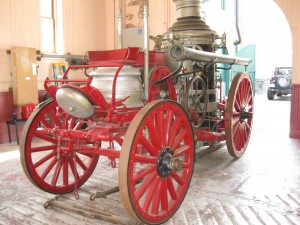 Steam-powered fire engines were not used in Charleston until more than 40 years after Robert Fulton made the technology possible. For most of the city’s history, the “engines” were little more than pumps on wheels that were pulled by hand or by horse through the city to water wells dug in the streets. A variety of early pumping methods included the capstan barrel, with holes on six or eight sides to connect horse-drawn poles that would spin the device and create hydraulic pressure.
Steam-powered fire engines were not used in Charleston until more than 40 years after Robert Fulton made the technology possible. For most of the city’s history, the “engines” were little more than pumps on wheels that were pulled by hand or by horse through the city to water wells dug in the streets. A variety of early pumping methods included the capstan barrel, with holes on six or eight sides to connect horse-drawn poles that would spin the device and create hydraulic pressure.
The 1860’s brought the steam engine into prominence, as companies in the northeast created a variety of contraptions that used steam pressure for suction and spray. Some of these engines, fulled loaded with boilders, pans, gauges, and hoses, weighed more than five tons, so what draft animals pull through the streets of Charleston pales in comparison.
After the first three city-wide fire houses were built in 1887, fires and heated water were constantly kept in separate non-mobile boilers for transfer to the engines to aid in rapid response to alarms, so that time was not wasted in waiting for the pressure to build. With successful digging of artesian wells in the city by the late 1870’s, a crude system of pressured water became available with mains and hydrants.
Steam engines pulled by horse were still in use into the 20th century, and the first motor-driven fire truck was purchased in 1912. Today, the old steamer in the picture stands inside the main fire house at 262 Meeting Street, as a reminder of the rustic nature of fire-fighting that served the city for so many years.